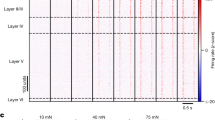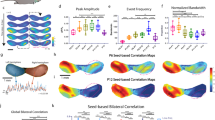Abstract
Brain-derived neurotrophic factor (BDNF) is a survival factor for certain sensory neurons during development. Using electrophysiology in BDNF-deficient mice, we show here that slowly adapting mechanoreceptors (SAM), but not other types of cutaneous afferents, require BDNF in postnatal life for normal mechanotransduction. Neurons lacking BDNF did not die, but instead showed a profound and specific reduction in their mechanical sensitivity, which was quantitatively the same in BDNF -/- and BDNF +/- animals. Postnatal treatment of BDNF +/- mice with recombinant BDNF completely rescued the mechanosensitivity deficit. Therefore BDNF is important for regulating SAM mechanosensitivity, independent of any survival-promoting function.
This is a preview of subscription content, access via your institution
Access options
Subscribe to this journal
Receive 12 print issues and online access
$209.00 per year
only $17.42 per issue
Buy this article
- Purchase on Springer Link
- Instant access to full article PDF
Prices may be subject to local taxes which are calculated during checkout




Similar content being viewed by others
References
Lewin, G.R. & Barde, Y.-A. Physiology of the neurotrophins . Ann. Rev. Neurosci. 19, 289– 317 (1996)
Maisonpierre, P.C. et al. NT-3, BDNF, and NGF in the developing rat nervous system: Parallel as well as reciprocal patterns of expression. Neuron 5, 501–509 (1990)
Snider, W.D. Functions of neurotrophins during nervous system development: what the knockouts are teaching us. Cell 77, 627–638 (1994)
Crowley, C. et al. Mice lacking nerve growth factor display perinatal loss of sensory and sympathetic neurons yet develop basal forebrain cholinergic neurons. Cell 76, 1001–1011 (1994)
Smeyne, R.J. et al. Severe sensory and sympathetic neuropathies in mice carrying disrupted Trk/NGF receptor gene. Nature 368, 246–249 (1994)
Ernfors, P., Lee, K.-F., Kucera, J. & Jaenisch, R. Lack of neurotrophin-3 leads to deficiencies in the peripheral nervous system and loss of proprioceptive afferents. Cell 77, 503– 512 (1994)
Klein, R. et al. Disruption of the neurotrophin-3 receptor gene trkC eliminates la muscle afferents and results in abnormal movements. Nature 368, 249–251 (1994)
Airaksinen, M.S. et al. Specific sub-types of cutaneous mechanoreceptors require neurotrophin-3 following peripheral target innervation. Neuron 16, 287–295 (1996)
McMahon, S.B., Armanini, M.P., Ling, L.H. & Phillips, H.S. Expression and co-expression of trk receptors in subpopulations of adult primary sensory neurons projecting to identified peripheral targets. Neuron 12, 1161–1171 (1994)
Koltzenburg, M., Stucky, C.L. & Lewin, G.R. Receptive properties of mouse sensory neurons innervating hairy skin. J. Neurophysiol. 78, 1841– 1850 (1997)
Korte, M. et al. Hippocampal long-term potentiation is impaired in mice lacking brain-derived neurotrophic factor. Proc. Natl. Acad. Sci.U.S.A. 92, 8856–8860 (1995)
Lawson, S.N. in Sensory Neurons: Diversity, Development, and Plasticity (ed. Scott, S.A.) 27–59 (Oxford University Press, New York, 1992)
Iggo, A. & Muir, A.R. The structure and function of a slowly adapting touch corpuscle in hairy skin. J. Physiol. (Lond.) 200, 763–796 (1969)
Mills, L.R., Nurse, C.A. & Diamond, J. The neural dependency of Merkel cell development in the rat: the touch domes and foot pads contrasted. Dev. Biol. 136, 61–74 (1989)
Nurse, C.A., Macintyre, L. & Diamond, J. A quantitative study of the time course of the reduction in Merkel cell number within denervated rat touch domes. Neuroscience 11, 521–533 (1984)
Stucky, C.L. & Koltzenburg, M. The low affinity neurotrophin receptor p75 regulates the function but not the selective survival of specific subpopulations of sensory neurons. J. Neurosci. 17, 4398–4405 (1997)
Fundin, B.T. et al. Differential dependency of cutaneous mechanoreceptors on neurotrophins, trk receptors, and P75 LNGFR. Dev. Biol. 190, 94– 116 (1997)
Wright, D.E. & Snider, W.D. Neurotrophin receptor mRNA expression defines distinct populations of neurons in rat dorsal root ganglia. J. Comp. Neurol. 351, 329–338 (1995)
Lindholm, D., Carroll, P., Tzimagiogis, G. & Thoenen, H. Autocrine-paracrine regulation of hippocampal neuron survival by IGF-1 and the neurotrophins BDNF, NT-3 and NT-4. Eur. J. Neurosci. 8, 1452 –1460 (1996)
Minichiello, L. & Klein, R. TrkB and TrkC neurotrophin receptors cooperate in promoting survival of hippocampal and cerebellar granule neurons . Genes Dev. 10, 2849–2858 (1996)
Wetmore, C. & Olson, L. Neuronal and nonneuronal expression of neurotrophins and their receptors in sensory and sympathetic ganglia suggest new intercellular trophic interactions. J. Comp. Neurol. 353, 143–159 (1995)
Apfel, S.C. et al. Nerve growth factor regulates the expression of brain-derived neurotrophic factor mRNA in the peripheral nervous system. Mol.Cell Neurosci. 7, 134–142 (1996)
Michael, G.J. et al. Nerve growth factor treatment increases brain-derived neurotrophic factor selectively in trkA-expressing dorsal root ganglion cells and in the central terminations within the spinal cord. J. Neurosci. 17, 8479–8490 (1997)
Ernfors, P., Lee, K.-F. & Jaenisch, R. Mice lacking brain-derived neurotrophic factor develop with sensory deficits. Nature 368, 147– 150 (1994)
Jones, K.R., Farinas, I., Backus, C. & Reichardt, L.F. Targeted disruption of the BDNF gene perturbs brain and sensory neuron development but not motor neuron development. Cell 76, 989– 999 (1994)
Tavernarakis, N. & Driscoll, M. Molecular modelling of mechanotransduction in the nematode Caenorhabditis elegans. Ann. Rev. Physiol. 59, 659–689 (1997)
Garcia, A.J. & Corey, D.P. The molecules of mechanosensation . Ann. Rev. Neurosci. 20, 567– 594 (1997)
Acknowledgements
This work was supported by the Deutsche Forschungsgemeinschaft, Sonderforschungsbereich 353 (MK). GRL was supported during the first stages of this work by an Alexander von Humboldt fellowship. The technical assistance of Anke Scheer (MDC) is acknowledged. We wish to thank Dr. Ilka Bergmann for her help with the confocal imaging and Dr. Cheryl Stucky for critical reading of the manuscript.
Author information
Authors and Affiliations
Corresponding author
Rights and permissions
About this article
Cite this article
Carroll, P., Lewin, G., Koltzenburg, M. et al. A role for BDNF in mechanosensation. Nat Neurosci 1, 42–46 (1998). https://doi.org/10.1038/242
Received:
Accepted:
Published:
Issue Date:
DOI: https://doi.org/10.1038/242
This article is cited by
-
Tactile sensitivity in the rat: a correlation between receptor structure and function
Experimental Brain Research (2021)
-
Asymmetric Sensory-Motor Regeneration of Transected Peripheral Nerves Using Molecular Guidance Cues
Scientific Reports (2017)
-
PIEZO2 is required for mechanotransduction in human stem cell–derived touch receptors
Nature Neuroscience (2015)
-
Neurochemical Characteristics of Sensory Neurons During Ontogeny
Neuroscience and Behavioral Physiology (2015)



